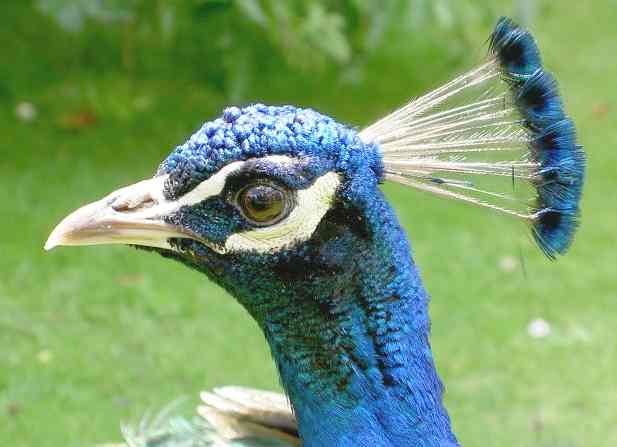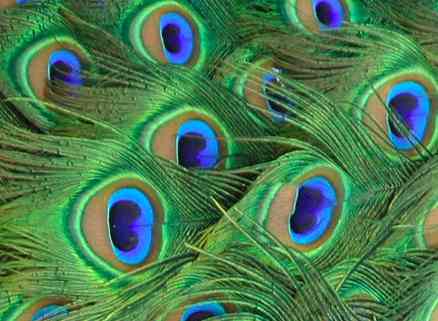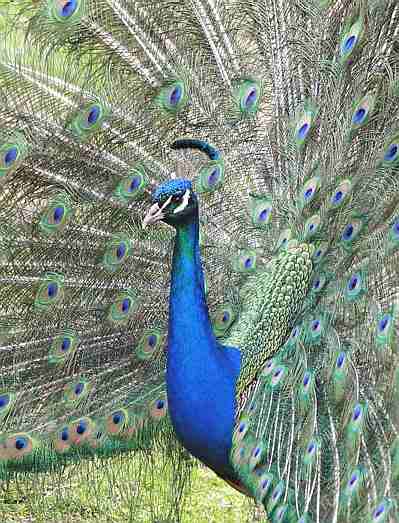THE PEACOCK of PEAFOWL
One bright summer day in 2003 I arrived at the Old Steam House in Herstmonceux, to be greeted by a pair of peacocks, who'd decided to move in. They'd built a nest in the rear garden and were strutting about quite happily on any available rooftop. You can see then on the balcony at the front of the building in the picture below. This is where they sunbathed. I supplied them with seed and water for about a week, then one day when visiting, these magnificent birds had disappeared. On inspection, I found their eggs had been smashed by vandals, which explained things. It is an understatement to say I was disappointed. NK
The term peafowl can refer to the two species of bird in the genus Pavo of the pheasant family, Phasianidae. They are best known for the male's extravagant tail, which it displays as part of courtship. The male is called a peacock, the female a peahen. Although commonly used, peacock is an incorrect term to refer to both sexes.
The two species are:
-
Indian Peafowl, Pavo cristatus (Asiatic)
-
Green Peafowl, Pavo muticus (Asiatic)
-
Peacocks in Sussex England: Herstmonceux
Overview
The Asiatic peafowl genus Pavo includes the familiar Indian Peafowl or Indian Blue Peafowl and the much rarer Green Peafowl or Dragonbird.
The Green Peafowl breeds from Myanmar east to Java. The IUCN lists the Green Peafowl as vulnerable to extinction due to hunting and a reduction in extent and quality of habitat.
Taxonomy
The Indian Peafowl is generally described as monotypic, while the Green Peafowl has 3 subspecies, P. muticus spicifer, P. m imperator and the nominate P. m. muticus.
The two species will hybridise in captivity, which has created some concern from conservationists as the Green Peafowl is evaluated as Vulnerable.
Controversies
While the form of Green Peafowl in Yunnan is not separated taxonomically, it differs in a few aspects from other forms, particularly in its forest-dwelling habits, an "odd, monal-like bill", a curiously long hind toe and longer, more slender wings (K. B. Woods in litt. 2000) [1]. Some have suggested this is a new subspecies.
Some taxonomists believe that the endangered Green Peafowl is actually a complex of several distinct species although they are currently treated as one species with three subspecies [2] [3], the same taxonomists also believe that the Indian Peafowl actually consists of two subspecies (second being Sri Lankan or Singhalese Peafowl, Pavo Cristatus Singhalensis), the nominate form having at least two geographical variations, and that Peafowl and their allies the argus pheasants are not related to phesants, and place them their own family, Pavoninidae.
Wolfgang Mennig, a foremost Green Peafowl breeder who works for the World Pheasant Association in Germany, believes that the subspecies imperator is really a group of four, or five subspecies: P. m. imperator, P. m. annamensis, P. m. angkorensis, and P. m. laotius. He also thinks that P. m. yunnanensis could be another subspecies in this group. He even says that some taxonomists believe there were ten subspecies.
The subspecies of the Pavo muticus imperator is divided into 4, or if the one that lives in west China yunnanensis counts, 5 different subspecies. There Pavo muticus imperator whose range is from central Thailand to Myanmar, the annamensis, or vietnamensis within the coastal range of Vietnam from north to south, and the angkorensis from Cambodia and the laotius in central Laos.
In a page on the German WPA site, there is a mentioning that annamensis, vietnamensis, angkorensis (called angkorensi), and laotius are all the same subspecies and are basically subspecies inside a subspecies, or geographical forms of the annamensis.

Indian Blue Peacock's head
Diet
Peafowl are omnivorous and consume plant parts, flower petals, seed heads, insects, and other arthropods, as well as reptiles and amphibians.
Although possessing metatarsal spurs—"thorns" used for kicking, they are used only for defence against predators.
Habitat
Asiatic peafowl like the Indian Blue Peafowl and especially the Green Peafowl occupy a similar niche as the roadrunners, Secretary Bird, and Seriema. All of these birds hunt for small animals, minnows, and arthropods on the ground, in shallow streams and frequently in tall grass habitats.
Peafowl inhabit tropical savannah and riparian forests where they hunt for small animals in close social units of related birds that may span many generations.
Plumage
The male (peacock) Indian Peafowl has beautiful iridescent blue-green or green coloured plumage. The so-called "tail" of the peacock, also termed the "train," is in fact not the true tail but highly elongated upper tail coverts. The train feathers have a series of eyes that are best seen when the tail is fanned. Both species have a head crest.
The female (peahen) Indian Peafowl has a mixture of dull green, brown, and grey in her plumage. She lacks the long upper tail coverts of the male but has a crest.
Females can also display their plumage to ward off danger to her young or other female competition.
The Green Peafowl is very different in appearance to the Indian Peafowl. The male has a more green and even gold plumage than the Indian Peafowl and even more brilliant color. The wings are black with a sheen of blue. The crest is of a very different shape and is tufted. The head is usually greenish in color, although the speculated new race/species P. (muticus) annamensis is said to have a bluer head than many other peafowl.
Unlike the Indian Peafowl, the Green Peahen is very similar to the male, only having shorter upper tail coverts and less iridesence. It is very hard to tell a juvenile male from an adult female. The female of the speculated race/species annamensis has an incredibly golden sheen, but that is exhibited in both sexes.
Many of the brilliant colors of the peacock plumage are due to an optical interference phenomenon (Bragg reflection) based on (nearly) periodic nanostructures found in the barbules (fiber-like components) of the feathers.
Different colours correspond to different length scales of the periodic structures. For brown feathers, a mixture of red and blue is required—one color is created by the periodic structure, while the other is a created by a Fabry-Perot interference peak from reflections off the outermost and innermost boundaries of the periodic structure.
Such interference-based structural color is especially important in producing the peacock's iridescent hues (which shimmer and change with viewing angle), since interference effects depend upon the angle of light, unlike chemical pigments.

Close-up of an Indian Blue Peacock's upper tail coverts
Behaviour
The peafowl are forest birds that nest on the ground. The Pavo peafowl are terrestrial feeders but roost in trees. Contrary to popular belief, Peafowl are very powerful and capable fliers.
Peafowl are considered to be polygamous. However in captivity, Green Peafowl are monogamous, with males assisting in nest defense, chick rearing, and chick brooding. The male's bond with offspring may extend indefinitely. First-year chicks that have been weaned by their mothers generally join their father's social unit to forage and rest.
In Green Peafowl, it is impossible to distinguish juvenile and subadult green peafowls from their mothers and hence their polygynous nature is hard to establish. There is some anectodotal evidence suggesting that Green Peafowl may have very complex social lives that may include the adoption of one and two year old juveniles by their three and four year old sub-adult siblings. It has been suggested that the supposed "females" that the male displays to in the wild, could really be juvenile birds, maybe even the males own young.
Peafowl are unusual amongst the Galliformes in their capacity for sustained flight. All known genera of the peafowl family exhibit complex flight displays.
Each race of the Green Peafowl has its own respective wing shape and flight display behavior. Green Peafowls in Java are often observed flying out to sea where the birds gather on islets some miles from shore.
All known species of peafowl perch on emergent trees that stand above the canopy. Chicks of Indian Peafowl are sometimes carried on the backs of the parent birds as they fly into the security of a tree to roost.
In the media
-
The American television network NBC has used three variations of a rainbow peacock logo since 1956.
Fictional References
In the novel Over the Wine Dark Sea by H N Turteltaub, the main characters transport a cargo of peafowl through the Mediterraneian Sea, circa 300 BC.
According to Greek mythology, the "eyes" on the tail of a peacock were placed there by Hera to commemorate her faithful watchman, Argus who had a hundred eyes (Ovid I, 625).
LINKS and REFERENCE
-
Blau, S.K. (Jan. 2004). "Light as a Feather: Structural Elements Give Peacock Plumes Their Color". Physics Today 57 (1): 18–20.
-
Loyau, A.; Saint Jalme, M., and Cagniant, C. (2005-05-03). "Multiple sexual advertisements honestly reflect health status in peacocks (Pavo cristatus)". Behavioral Ecology and Sociobiology 58 (6): 552-557. ISSN 0340-5443 (Print); ISSN 1432-0762 (Online).
-
"The Peacock Information Page: All About Peacocks!", an article by Lisa Johnson from Game Bird and Conservationists' Gazette — Aspects of the cultural role of peafowl and their place in aviculture
-
"Peacocks Swarm Couple's Florida Home" — Feral peafowls became pests for one Florida couple in 2005, a CBS Evening News story
-
Peafowl in Arcadia, Living With Arcadia's Wild Birds, a pamphlet by City of Arcadia, California (pdf)
-
"Behavioural Ecologists Elucidated How Peahens Choose Their Mates, And Why", an article at ScienceDaily.com
-
Peafowl videos on the Internet Bird Collection
-
Peacock — Etymology of the word
-
Unusual Blue-White peacock from Sydney, Australia (circa March 2006)
Peacock displaying - Melbourne Zoo
BIRD INDEX:
|
Bishop, Orange Canary Chaffinch Chicken Cormorant Cuckoo Dodo Eagle Falcon Finch Grebe Grouse Hawk Herons House
Martin Ibis,
Sacred Kingfisher |
Kiwi Lilac-Breasted Roller Loon Mynah Nightjar Parrot,
Amazon Partridge Pelican Penguin Petrel Pheasant Quail Robin Seagull Sparrow Starling Stork Swan Swift Turkey Wader Woodcock Woodpecker |
Please use the Index below to navigate the Animal Kingdom:-
OTHER ANIMALS:
|
The story blend of fact and fiction is ideal adventure film material of the Moby Dick / Free Willy genre (Moby Dick was based on real whale attacks on whaling boats).
This website is Copyright © 1999 & 2025 Electrick Publications & Blueplanet Netdirect Productions.
The bird logos and name Solar Navigator are trademarks. All rights reserved. Max Energy Limited is an educational charity working hard for world peace
